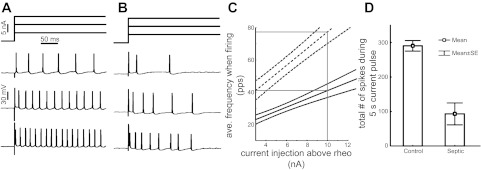Fig. 2.

Motoneurons fire more slowly in septic rats. Shown at the top of A and B is the pulse paradigm for current injection into motoneurons from a control (A) and a septic (B) rat. Shown below the pulse protocols are the firing pattern triggered by each of the 3 current injections. With increasing current injection into the control motoneuron (A), it fires more rapidly (bottom traces). B: the motoneuron from the septic rat fires more slowly than the control at each level of current injection. C: plotted are the average (ave.) and 95% confidence intervals of firing frequency vs. current injection above rheobase for control (dashed line) and septic (solid line) motoneurons. Both the initial firing rate and the slope of the relationship are reduced in motoneurons from septic rats (P < 0.01 for both comparisons). D: plotted is the mean number of spikes in response to a 5-s current injection at 10 nA above rheobase for motoneurons from both control and septic rats. Motoneurons from septic rats fire approximately ⅓ as many spikes as motoneurons from control (P < 0.01). n = 6 control and 8 septic motoneurons.pps, Pulses per second; rheo, rheobase current, the minimal current sufficient to trigger an action potential.
